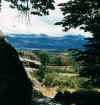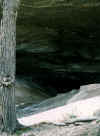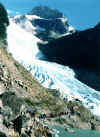The pier in Puerto Natales
The bus has dumped me at its final stop, an intersection in "downtown" Puerto Natales. While I put the bike back together I wave away the teenagers who try to sell me their particular lodging. I have my own addresses, of two hostels recommended by Manuel in Punta Arenas the day before. These names mean nothing to me and I pick the first one, Casa Cecilia.
Some young folks show me the approximate direction. I try to follow the grid of roads but it is not perfect and "Tomas Rogers" is not easy to find as is ends at "Bulnes". But I get there finally, pedalling against the one-way designation of this street. By the way, don’t pronounce Rogers the American way, no one will understand you. The "g" in Rogers should be like the "ch" in the Scottish "loch"
Casa Cecilia is a low building, just another one-storey house on this residential street. There is a sign on the lawn and, re-assuringly, a tent has been pitched outside for drying. They are full, says Cecilia, the woman of the house, but she calls another hostel, which was my second choice, and secures my bed there. I move across town, digesting the good reception that I had received at Cecilia’s. Also, I had peeked into Cecilia's common area and sensed the warmth of a real home rather than the usual assembly of near-expiry furniture. I resolve to try there again some other time, if I should get the chance. It is late, and I cycle over to "Don Bosco’s". After I after put down my packs and put things on my bed to mark it "occupied", I head out again for dinner.
The next day I shop for my trip into the mountains. Shops do not open before 9:30, but I am out earlier anyways and look for a chance to get more information on the park. I strike it lucky when I stop a stranger whose determined gait makes him unlikely to be a tourist. He does not look local either, he's got a good north-American jacket. Alex is a guide in Torres del Paine and tells me that one cannot buy any bread in the park itself. Thus I will have to buy bread for all the days that I intend to spend there. He also tells me about a back road into the park that cuts 30 km off the official route and goes through pretty mountains. It is called the "new road" and has not been opened to the public yet; so I will have to ask for permission to use it. And the bridges there are partially dismanteled to stop cars, but a bicycle can be pushed across.Why is it private, I ask? The owner of the land has built it with the understanding he will get certain concessions in the park, Alex confides. These concessions are not materializing and thus the gate stays shut. Ah, politics!I do my shopping: bread, pasta, cheese, jam, salami, soups and dried fruit; enough food for 2 days to cycle to the park, plus 4 days in Torres del Paine and an additional 3 days to return. After I have shopped and packed, I am shocked at the weight that this food adds to my baggage. Back at the hostel, I ask that they prepare lunch for me; when I sit down to eat, it's a huge amount and I cannot finish.
Then, at about noon, I set out on my loaded "Rosinante", pedalling the road along the Sena de la Ultima Esperanza where hundreds of black-necked swans search the shallow shore waters for food. I cycle past the abandoned meat plant, past the small airport, on to the Cueva del Milodon and to Torres del Paine, one of Chile's finest National Parks.
I stay in the Torres del Paine park only for one day. On the return trip, I get a lift with a pickup, that takes me from Cerro Castillo straight into Puerto Natales. The driver is a social worker for a catholic organization. He likes his job, but he deplores the situation of the young folks. According to him, 40% of the youth in Puerto Natales drink alcohol and of those, one in five is addicted. We talk in Spanish, with me guessing and stumbling along, and he apologizes for not speaking English well. He’s had seven years of English in school and feels he has learned nothing. I understand his frustration, but I am not sure my Spanish was good enough to convince him to take a different outlook. He has a good basis of grammar and vocabulary, and two weeks of immersion would make him fluent and able to communicate. It’s silly that the system is not smart enough to follow up a seven-year effort with two weeks to make the study an obvious and enjoyable success.
In Puerto Natales, booking the ferry is simple, a bunk is available in "economy" and it costs me an extra 15000 pesos (about US$30) to take my bike along. I had missed the previous boat by only a day and will have to wait for six days for the next one. This is no problem for me: I have no time table and I need the rest.
For starters, I cycle over to Casa Cecilia and they take me in. I'm in luck, I get a room by myself and thus spend the next six days in the bliss of privacy.
Casa Cecilia is special among the many hostels of the South: I had sensed that when I had poked my head into its doorway a few days earlier. Cecilia and Werner treat you as a guest first, and then as a customer. At some point, I sit down and take the trouble to detail what makes this place special:
- the common area is a living room, furnished as if it was their own. The furniture is solid, comfortable and respectable; the electronics are made by Sony and include a CD player which plays classical music; there are interesting books on the shelves with a little sign telling that you may exchange one of your books with one on the shelf but you need Werner's OK; children's drawings are on the wall to add to the decorations: wherever you look it's "home".
- an information board is up, where fellow travelers extol the virtues of such and such a hostel in the next town or caution against a rip-off that's waiting at some other place.
- they allow you to cook your own meals, as many hostels down there do, but as an extra touch there is a shelf where you can put surplus food for others to use: a great way to avoid waste and help others
- they rent out trekking equipment which is good quality and they are fair with the charges when damages occurred, I am told
- the breakfast is maybe the best anywhere in Patagonia: they bake their own sourdough bread and do not limit how much you may take; there are 3 types of jam on the table, all of them good; there's a jug of hot milk for the folks who like it, there's butter on the table, not margarine; you get a large glass of real juice; there's coffee and tea; and to top it off, every day there's a special surprise such as Muesli, crepes, cake, yogurt or a quality cheese. All for just a bit more than one US dollar.
Casa Cecilia:
Book ahead because the closer to the date of the ferry arrival/departure, the higher the chance they are full. Thus, call ahead and secure a place. Werner speaks English, Spanish and German (and maybe more), Cecilia probably will understand enough English to make a booking. (I hope I got that right....) A time that's not so busy for them is mid-afternoon, and a busy time is around breakfast and early evening. Chile's time zone is one hour ahead of New York, but daylight saving time differences change this. I haven't figured out a reliable rule yet...Owners: Cecilia and Werner Address: Tomas Rogers 60, Puerto Natales, Chile tel. 061 411 797.
Puerto Natales is still a worker's town: the fishing, agriculture and the mine have provided people an income. Tourism is new, and I dread the day when the old-timers will be gone and greed will make this just another tourist place.
I have time to tour the area: explore the coast east of the town, to take a boat trip to the two glaciers nearby, and to climb up the Sierra Dorotea that overlooks Puerto Natales..
.
people on the trip to the glacier Bernardo O'Higgins
Then, on Thursday evening, my waiting in Puerto Natales comes to an end. I say good-bye to Werner and Cecilia and board the Puerto Eden, the ferry that will take me up the coast for more than a thousand kilometers
Forward to Torres del Paine
Back to Trip Overview
Back to Erhard's Home page



 The cave is shaped like a sock, and the wide mouth admits light enough to
let you walk to the back of its 200m depth without a flashlight. A path has been built so
one can walk its full length and there stands a life-sized statue of the Mylodon near the
exit. Kids gawk at it, and adults ridicule it as a fiberglass monstrosity. In my opinion,
it's pretty well-done and the adults just don't want to admit that they are impressed and
intimidated by the clawed monster.
The cave is shaped like a sock, and the wide mouth admits light enough to
let you walk to the back of its 200m depth without a flashlight. A path has been built so
one can walk its full length and there stands a life-sized statue of the Mylodon near the
exit. Kids gawk at it, and adults ridicule it as a fiberglass monstrosity. In my opinion,
it's pretty well-done and the adults just don't want to admit that they are impressed and
intimidated by the clawed monster. 



